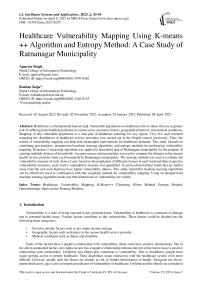Healthcare Vulnerability Mapping Using K-means ++ Algorithm and Entropy Method: A Case Study of Ratnanagar Municipality
Автор: Apurwa Singh, Roshan Koju
Журнал: International Journal of Intelligent Systems and Applications @ijisa
Статья в выпуске: 2 vol.15, 2023 года.
Бесплатный доступ
Healthcare is a fundamental human right. Vulnerable populations in healthcare refer to those who are at greater risk of suffering from health hazards due to various socio-economic factors, geographical barriers, and medical conditions. Mapping of this vulnerable population is a vital part of healthcare planning for any region. Very few such research regarding the distribution of healthcare service providers was carried out in the Nepali context previously. Thus, the results of vulnerability mapping can help with meaningful interventions for healthcare demands. This study focused on combining geo-analytics, unsupervised machine learning algorithms, and entropy methods for performing vulnerability mapping. K-means++ clustering algorithm was applied to household data of Ratnanagar municipality for the purpose of creating multiple clusters of households. An open-source routing machine was used to compute the distance to the nearest health service provider from each household in Ratnanagar municipality. The entropy method was used to evaluate the vulnerability measure of each cluster. Later, based on the population of different clusters in each ward and their respective vulnerability measures, each ward’s vulnerability measure was quantified. It can be observed that wards that are farther away from the east-west highway have higher vulnerability indices. This study found that machine learning algorithms can be effectively used in combination with the weighting method for vulnerability mapping. Using an unsupervised machine learning algorithm made sure that dimensions of vulnerability are visible.
Healthcare, Vulnerability Mapping, K-Means++ Clustering, Elbow Method, Entropy Method, Openstreetmap, Open-source Routing Machine
Короткий адрес: https://sciup.org/15018992
IDR: 15018992 | DOI: 10.5815/ijisa.2023.02.05
Список литературы Healthcare Vulnerability Mapping Using K-means ++ Algorithm and Entropy Method: A Case Study of Ratnanagar Municipality
- D. B. Waisel, “Vulnerable populations in healthcare,” Curr. Opin. Anaesthesiol., vol. 26, no. 2, pp. 186–192, 2013, doi: 10.1097/ACO.0b013e32835e8c17.
- M. Marmot, J. Allen, R. Bell, E. Bloomer, and P. Goldblatt, “WHO European review of social determinants of health and the health divide,” Lancet, vol. 380, no. 9846, pp. 1011–1029, 2012, doi: 10.1016/S0140-6736(12)61228-8.
- GoN, “The Constitution of Nepal 2015,” Nepal Gaz., vol. 2015, no. February, p. Art. 58., 2015, [Online]. Available: http://www.lawcommission.gov.np.
- P. Neupane, D. Bhandari, M. Tsubokura, Y. Shimazu, T. Zhao, and K. Kono, “The Nepalese health care system and challenges during COVID-19,” Journal of Global Health, vol. 11, 2021.
- S. K. Aksha, L. Juran, L. M. Resler, and Y. Zhang, “An Analysis of Social Vulnerability to Natural Hazards in Nepal Using a Modified Social Vulnerability Index,” Int. J. Disaster Risk Sci., vol. 10, no. 1, pp. 103–116, 2019, doi: 10.1007/s13753-018-0192-7.
- B. M. de Loyola Hummell, S. L. Cutter, and C. T. Emrich, “Social Vulnerability to Natural Hazards in Brazil,” Int. J. Disaster Risk Sci., vol. 7, no. 2, pp. 111–122, 2016, doi: 10.1007/s13753-016-0090-9.
- E. Mavhura, B. Manyena, and A. E. Collins, “An approach for measuring social vulnerability in context: The case of flood hazards in Muzarabani district, Zimbabwe,” Geoforum, vol. 86, no. December 2016, pp. 103–117, 2017, doi: 10.1016/j.geoforum.2017.09.008.
- O. Žurovec, S. Čadro, and B. K. Sitaula, “Quantitative assessment of vulnerability to climate change in rural municipalities of Bosnia and Herzegovina,” Sustain., vol. 9, no. 7, pp. 1–18, 2017, doi: 10.3390/su9071208.
- W. Shi and W. Zeng, “Genetic k-means clustering approach for mapping human vulnerability to chemical hazards in the industrialized city: A case study of Shanghai, China,” Int. J. Environ. Res. Public Health, vol. 10, no. 6, pp. 2578–2595, 2013, doi: 10.3390/ijerph10062578.
- Central Bureau of statistics, “Professionalism in action,” 2015.
- The World Health Organization (WHO), “Under-five mortality rate (probability of dying by age 5 per 1000 live births),” The Global Health Observatory, 2020. https://www.who.int/data/gho/indicator-metadata-registry/imr-details/7.
- GoN, Senior citizens, vol. 87, No. 1–2. 2006, pp. 1–4.
- R. Seising, “Bell System Technical Journal.,” American Scientist. p. 60, 2001.


